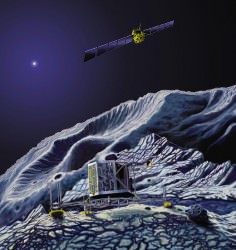Now that Rosetta has (leisurely) arose from a 31-month slumber in space, the next step is to figure out how prepared the spacecraft is for its close encounter with a comet. Early indications show that the orbiting spacecraft is ready to go. Its lander, Philae, is still asleep and the plan isn’t to wake it up until March, ESA added.
In the initial wake-up stage for Rosetta, “We were most concerned about power, and seeing if the solar arrays were generating sufficient electricity to support the planned recommissioning activities,” stated Andrea Accomazzo, spacecraft operations manager. “But even though we were still 673 million km [418 million miles] from the Sun , we were getting enough power and the arrays appear to have come through hibernation with no degradation.”

Other systems are happily coming online as planned. Three of the four reaction wheels, which control Rosetta’s position in space, are working perfectly (with the fourth expected to be reactivated in a few weeks.) Next up is making sure Rosetta’s memory storage is working well enough to shelve science and operations information, and pinning down the spacecraft’s orbit.
So Rosetta is doing well after 31 months. With that hurdle leapt, technicians will begin to think about waking up Philae and making sure that its 10 instruments are working. By February, you can follow updates regularly on the Rosetta blog (as well as on Universe Today, of course!)
Rosetta should reach Comet 67P/Churyumov-Gerasimenko in August, and will start snapping pictures of the comet in May if all goes to plan. Astronomers are eager to see what the comet will teach us about the early years of the solar system, since comets are considered leftovers of when our neighborhood formed.
Source: ESA

